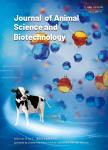Disappearance and appearance of an indigestible marker in feces from growing pigs as affected by previous-and currentdiet composition
Disappearance and appearance of an indigestible marker in feces from growing pigs as affected by previous-and currentdiet composition作者机构:Department of Animal ScienceIowa State UniversityAmes 50010USA Department of Animal and Food SciencesUniversity of KentuckyLexington 40546KYUSA USDA-ARS-National Laboratory for Agricultural and the EnvironmentAmes 50010IAUSA
出 版 物:《Journal of Animal Science and Biotechnology》 (畜牧与生物技术杂志(英文版))
年 卷 期:2017年第8卷第3期
页 面:643-651页
核心收录:
学科分类:0710[理学-生物学] 0831[工学-生物医学工程(可授工学、理学、医学学位)] 0832[工学-食品科学与工程(可授工学、农学学位)] 1004[医学-公共卫生与预防医学(可授医学、理学学位)] 0905[农学-畜牧学] 0906[农学-兽医学] 09[农学] 0703[理学-化学] 0836[工学-生物工程]
基 金:the National Laboratory for Agriculture and the Environment (Ames, Iowa) for laboratory assistance. Appreciation is also expressed to H. J. Monegue and W. Patton (University of Kentucky, Lexington) for assistance in the care of pigs and to D. Higginbotham (University of Kentucky, Lexington) for help in diet preparation and to Akey Inc. (Lewisburg, OH) and DSM Nutritional Products Inc. (Parsippany, N J) for ingredients used in the diets. Mention of a trade name, proprietary product, or specific equipment does not constitute a guarantee or warranty by the USDA, Iowa State University, or the University of Kentucky and does not imply approval to the exclusion of other products that may be suitable. The USDA is an equal opportunity provider and employer
主 题:Adaptation Digestibility Fiber Indigestible marker Pig
摘 要:Background: Indigestible markers are commonly utilized in digestion studies, but the complete disappearance or maximum appearance of a marker in feces can be affected by diet composition, feed intake, or an animal's *** objectives of this study were to determine the impact of previous(Phase 1, P1) and current-(Phase 2, P2)diet composition on marker disappearance(Cr) and appearance(Ti) in pigs fed 3 diets differing in NDF ***: When pigs were maintained on the 25.1, 72.5, and 125.0 g/kg NDF diets, it took 5.1, 4.1, and 2.5 d, respectively,for Cr levels to decrease below the limit of quantitation; or 4.6, 3.7, or 2.8 d, respectively, for Ti to be maximized. These effects were not, however, independent of the previous diet as indicated by the interaction between P1 and P2 diets on fecal marker concentrations(P 〈 0.01). When dietary NDF increased from P1 to P2, it took less time for fecal Cr to decrease or fecal Ti to be maximized(an average of 2.5 d), than if NDF decreased from P1 to P2 where it took longer for fecal Cr to decrease or fecal Ti to be maximized(an average of 3.4 d).Conclusions: Because of the wide range in excretion times reported in the literature and improved laboratory methods for elemental detection, the data suggests that caution must be taken in considering dietary fiber concentrations of the past and currently fed diets so that no previous dietary marker addition remains in the digestive tract or feces such that a smal amount of maker is present to confound subsequent experimental results, and that marker concentration have stabilized when these samples are col ected.



